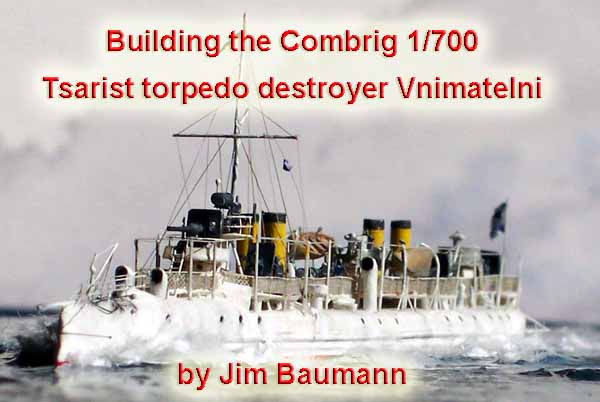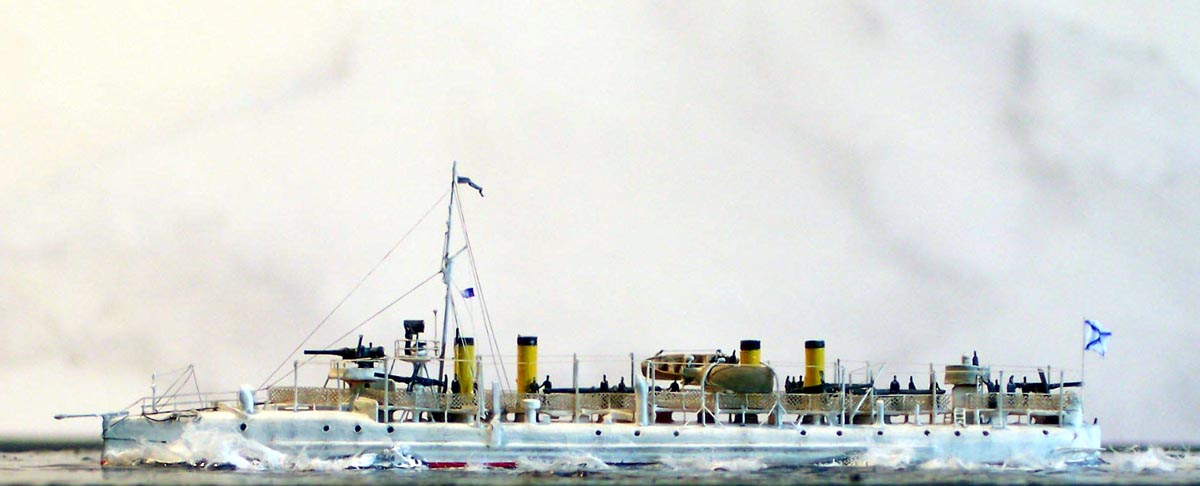 |
| The four funneled Vnimatelni class (literal translation
= alert/watchful) of 5 units were built for the Tsarist Navy in France,
with the subject of this model being built by Normand, laid down in 1898
and completed in 1901. Decidedly French in design with their turtle decks
and suspended main deck of grating they resembled somewhat the Durandal
class and were swift and elegant. The fate of these sisters was mixed,
two being sunk by IJN gunnery, two eventually being taken over by the Royal
Navy in 1918 and subsequently scrapped in 1921, whilst the subject of this
model, Vnimatelni was wrecked on 26 May 1904.
Specifications
| Length Over All |
185 ft 8 in |
| Displacement |
312 tons |
| Propulsion |
Coal fired boilers 5200 iHP |
| Speed |
26.5 kits(!) |
| Armament |
1 x 11 pdr |
|
5 x 3 pdr |
|
2 x 15 in Torpedo tubes |
| Complement |
59 crew |
|
|
| This model was built using the Combrig 1/700 resin kit;
which appears to be based on the side elevation, perspective and cross
section drawings found in issue No 1/ 2000 Morskaya Kollektsiya, a really
excellent publication which I used extensively as reference myself along
with a number of photos from various on-line resources.
Upon opening the box one is initially surprised by the diminutive size
of the hull in 1/700, not even 3 1/4 inches loa . The kit comprises the
essential parts of hull, deck, TT and guns. |
click images
to enlarge |
 |
| Alas the cast deck is way to thick in scale. I was tempted
to replace it with thin styrene but was put off by potential later warping
problems , a new brass deck was discounted due to differential expansion
problems of dissimilar materials. I elected to use the supplied deck but
scraped away at the edges to near scale , tapering inboard so as to maintain
a near scale height above the hull. |
| The deck was supported on the real ship by a myriad of struts and girders
on the model this was simplified by supporting the deck on funnel and hatch
stubs. I then added the through deck gun mount struts and stays, as well
as a number of struts around the deck edge. Ammunition hatches (and the
shaft trunks between under deck and hull were added)
I wished to portray the vessel at speed (inspired by the cover illustration
of the MK magazine!). |
 |
| To allow some of the lower hull to be seen I added a thin
piece of styrene sheet and sanded to the appropriate shape. This was then
painted anti fouling color, and the hull mounted in a wave pattern of white
glue. |
 |
 |
| The kit supplied funnels at first made a good impression but careful
study of plans and photos suggested they may be a little thick this was
compounded by needing to get 3 coats of paint on to achieve density as
well as steam pipes on the funnels. So despite having cemented them to
the deck I decided to remove them and install replacements made of brass
tubing; these had a groove cut into them with a tube cutter to assist painting
the color separation between the black and yellow. |
 |
| The 11 pdr platform mounted atop the conning tower was supplied as
a resin item, cast onto a wafer of varying thickness. . I attempted ( unsuccessfully!)
to sand this evenly to a near scale thickness. but it collapsed immediately
prior to success... I made a new platform base using a PE funnel cap from
the WEM Askold set, in-filled the gaps with CA . |
 |
| I then added two bar GMM Gold-plus railing this was partially
infilled with white glue to simulate the part splinter shield/railing combination.
The searchlight platform was made in a similar manner, the searchlight
itself was made of stretched sprue and the supporting bracket of PE railing
scrap bent to shape.
The mast abaft the bridge was installed, unusually this was offset to
stbd. of the centerline on the real ship and therefor on my model also
- for reasons I cannot fathom. |
| The main challenge on this model was that of adding the netting to
the deck edge rails these were white on the original vessel the PE items
when painted looked too dense and did not allow the 'see-thru' effect I
desired. I hunted through haberdashery stores, buying a yards of fabric
ranging from wedding dress veils to mosquito netting, air filter mesh to
hosiery....
Eventually at a jumble sale I came across an old little rectangular
timber frame ( 6 " x 3") labeled 'Letraset Carrier frame. |
 |
| This frame was spanned with the finest mesh giving the desired airy
look when dry brushed with thin white paint giving a recognizable mesh
pattern. This was attached to the inside of the previously fitted rails
using thinned matt varnish applied with a fine pointed brush. |
 |
|
|
 |
| The awning stanchions were cut from 1/350 PE handrail longitudinals
and rigged with white stretched sprue as per photos. The aft companionway
spray hoods were made of scrap PE parts and given a cover of thinned white
glue as were the canvas dodgers covering the railings of the conning platform.
Anchors, simulated chain, and various other details including coal scuttles
and small hatches, doors, platform supports, davits and boats completed
the model, which was then rigged using black stretched sprue for the standing
rigging and brown sprue for the signal halyards. The naval ensign aft was
made using a blue ball-point pen on thin paper.
Conclusions
All in all a delightful model, which despite its small size held my
interest all the way through the build.
A website
with useful views of all members of the class
Morskaya Kollektsia magazine was obtained from Sergey
Myagkov's website |
| The
ships of Jim Baumann |














